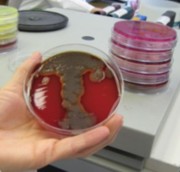
Bacterial Identification
last authored: Feb 2010, David LaPierre
last reviewed:
Introduction
 Bacterial cultures are useful for evaluating growth on differential media, testing antibiotic sensitivity and resistance, and selecting colonies for further testing.
Bacterial cultures are useful for evaluating growth on differential media, testing antibiotic sensitivity and resistance, and selecting colonies for further testing.
Infectious disease diagnostics allows for identification of pathogens and the risk they carry, as well as insight into their susceptbility to antimicrobial therapy. Currently, diagnostics lags behind treatments. There is a huge need to focus on this area. Infectious disease diagnostics are most often done in laboratories in tertiary care settings, but can also be done in point-of-care settings such as family doctor's offices, pharmacies, community centres, or mobile clinics.
- staining
- culture
- biochemical tests
- serology
- molecular diagnostics
Staining
Bacterial samples can be stained using tissue (pus, sputum, etc) or culture (urine, blood, etc). The gram stain is the cornerstone of bacterial staining.
Other common stains include the Giemsa stain (malaria and other parasites), the Ziehl-neelsen stain (for M. tuberculosis and other acid-fast organisms), and others.
The University of Utah's excellent WebPath staining tutorials provide much information about staining techniques.
Culture
Culture provides expansion of bacterial numbers, helping with their identification and evaluation of sensitivity to various antibiotics.
Bacterial samples can be stained using tissue (pus, sputum, etc) or culture (urine, blood, etc). The gram stain is the cornerstone of bacterial staining.
Blood agar is the most commonly used plate, growing alomst every organism except Hemophilus. It can also be used to grow fastodious organisms and test for hemolytic capacity.
Chocolate contains extra nutrients and grows Hemophilus.
BH (brain/heart) is used for anerobes.
McKonkey is used to grow gram-negative bacteria and test them for lactose fermentation.
PEA - selective for gram +ve
Other plates include pen-strep (for yeast), Mannitol salts (for strep), or OFPBC.
hemolysis
alpha-hemolysis is a greeninsh coloring in plates due to hydrogen peroxide production. Most upper airway Streptococci are alpha-hemolytic.
beta-hemolysis is a clear zone around colonies, representing RBC lysis.
Biochemical Tests
Enzymatic activity can be used to distinguish bacteria. One common mechanism is to examine carbohydrate fermentation. Different sugars include:
- glucose
- lactose
- galactose
- sucrose
Enterobacteriacae (Escherichia, Enterobacter, Shigella, Citrobacter, Samolnella) are all oxidase-negative.
An important discriminant is Staph vs Strep. Staph is catalase +ve. S. aureus is coagulase +ve.
Serology
Serology uses antibodies to determine the presence of specific pathogens.
A slide agglutination test uses known antibodies against an unknown bacteria.
ELISA and Western blotting can also be helpful.
Molecular Diagnostics
Some tests include:
DNA sequencing
Restriction fragment analysis
PCR
DNA chips
Molecular and biochemical techniques allows sophisticated and rapid indentification of pathogens. There is a strong move towards using PCR, ELISA, Western blotting, and other techniques. We are limited only by our willingness to learn and adopt these extremely powerful approaches.
